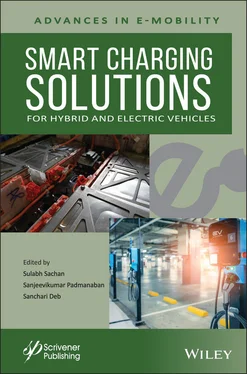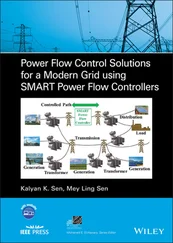Smart Charging Solutions for Hybrid and Electric Vehicles
Здесь есть возможность читать онлайн «Smart Charging Solutions for Hybrid and Electric Vehicles» — ознакомительный отрывок электронной книги совершенно бесплатно, а после прочтения отрывка купить полную версию. В некоторых случаях можно слушать аудио, скачать через торрент в формате fb2 и присутствует краткое содержание. Жанр: unrecognised, на английском языке. Описание произведения, (предисловие) а так же отзывы посетителей доступны на портале библиотеки ЛибКат.
- Название:Smart Charging Solutions for Hybrid and Electric Vehicles
- Автор:
- Жанр:
- Год:неизвестен
- ISBN:нет данных
- Рейтинг книги:4 / 5. Голосов: 1
-
Избранное:Добавить в избранное
- Отзывы:
-
Ваша оценка:
- 80
- 1
- 2
- 3
- 4
- 5
Smart Charging Solutions for Hybrid and Electric Vehicles: краткое содержание, описание и аннотация
Предлагаем к чтению аннотацию, описание, краткое содержание или предисловие (зависит от того, что написал сам автор книги «Smart Charging Solutions for Hybrid and Electric Vehicles»). Если вы не нашли необходимую информацию о книге — напишите в комментариях, мы постараемся отыскать её.
The most comprehensive and up-to-date study of smart charging solutions for hybrid and electric vehicles for engineers, scientists, students, and other professionals. Smart Charging Solutions for Hybrid and Electric Vehicles:
Smart Charging Solutions for Hybrid and Electric Vehicles — читать онлайн ознакомительный отрывок
Ниже представлен текст книги, разбитый по страницам. Система сохранения места последней прочитанной страницы, позволяет с удобством читать онлайн бесплатно книгу «Smart Charging Solutions for Hybrid and Electric Vehicles», без необходимости каждый раз заново искать на чём Вы остановились. Поставьте закладку, и сможете в любой момент перейти на страницу, на которой закончили чтение.
Интервал:
Закладка:
For example, consider a densely populated building where the people reside on multiple floors. The parking spot where the charging or discharging of EVs will occur is obviously very compact. Hence, a single controller will be making decisions for multiple EVs. Assume another scenario where the buildings are spatially distributed and the number of persons living in each building is less than the previous scenario. In the second scenario, the parking spot where the charging or discharging of EVs occurs will also not be dense, so single controller can make decisions for multiple buildings. Hence, the demography of an area plays a critical role. On the other side, when topography is looked into, the decentralized controller is preferred, practically, for hilly or mountainous regions. The deployment of communication systems for hilly regions is challenging compared to the plane area.
1.8 Outlook towards Smart Charging
EVs are looked upon as a key to unleashing the potential of clean transportation and low-carbon emission electricity. The push for electrification of the transport sector has brought changes in the operations of current utility grids with a rise in the integration of renewable energy sources. Renewable energy sources are spatially distributed in nature; EVs’ mobility and the capability to smart charge and discharge are seen as impactful in integrating renewables to the grid. The outlook of smart charging infrastructure has a wide perspective, which is drawn based on the geography of the land where the infrastructure will be developed, the system analysis time frame, the focus of the impact study, and the society.
The geography of the land helps decide the type of control architecture to be deployed for smart charging. Apart from control architecture, the availability of renewables is also considered. Consider a remotely located region with hilly terrain. The control architecture for such a region is preferred to be distributed, due to capital investment in developing communication architecture. The availability of renewables introduces another opportunity to develop an isolated grid rather than connecting to a larger grid. Hence, the potential of renewables in generating electricity is analyzed and, if the power generation can meet the load demand, an isolated grid is developed. An isolated grid will have a separate control and communication system whose design and deployment will require less capital investment. Apart from less capital investment, deploying smart charging infrastructure on an isolated generation system will be less complicated, easier to monitor, control, and operate, and have a low risk of losses incurred due to the controller’s failure or any fault in the system.
The time frame of analysis is another vital aspect to be considered while planning to deploy a smart charging infrastructure. The time frame can have short term or long-term impact. Short-term impact analysis is helpful in operational planning and to perform upgrading of the system. The local impact and system-wide impact are required to be accessed at a regular interval of time. The impact study can result in invaluable insights that can help increase reliability and long-term sustainability. The integration of renewables and an extension of services provided by EVs, such as peak load management and ancillary services, can be made using time frame analysis [66, 79].
The impact study is not limited to technical analysis and proposed upgrades; social acceptance is another barrier to be considered while pushing the use of EVs in the transportation sector. Social acceptance is dependent on the existing grid infrastructure, services provided, and reliability. The smart charging infrastructure is dependent on electricity to operate and manage. Hence, before planning for shifting towards smart charging, it is essential to build confidence by increasing power reliability with the least outages. A balance between society’s interest (subsidized charging cost and support if subscribed to smart charging) and the operators’ (profits to hold operation and management of company/organization) of smart charging is required [80, 81]. Policy support worldwide also plays a significant role in the social acceptance of EVs and smart charging. Socio-technical analysis at different time frames and implementing recommendations at regular intervals can facilitate greater business opportunities to both operators and EV users [82].
1.9 Conclusion
Smart charging is supposed to be the future of EV charging. With the visible paradigm shift towards transport electrification, policymakers are framing and modifying existing policies to ensure success in implementation. Although the push of countries around the world is based on the sustainable energy goals of the United Nations, without increasing the generation capacity based on the renewables, it is difficult to harness optimal results for reduced carbon emissions. Further, an increased number of EVs will demand an innovative, intelligent, and robust charging infrastructure. Infrastructure development planning should consider every entity and its interests in the deployment. Power and energy management solutions should reduce the burden of the utility grid as well as ensure that each EV user is not barred from their requirements. The present smart charging systems are developed considering either one of the ideas or technology, such as ToU, V2G, V2B/V2H, for dynamic pricing control. If these technologies or ideas are implemented together, there are chances to satisfy the requirements of each stakeholder, although the optimization problem statement might be very complex.
The complete chapter is briefly described below:
1 The chapter defined the context of “smart”, followed by approaches a developer takes to make a system smarter.
2 The context of smart is extended to define an outlook of smart charging and its requirements.
3 The components and enablers are discussed in detail to conceptualize the smart charging architecture.
4 The robust control systems involved in developing smart charging systems are introduced as centralised and decentralised architectures. Discussions are made to enable the reader to decide the topology suitable based on the location’s topography.
5 A perspective on the communication between energy market entities, which involves two different ends of the smart charging ecosystem (EV manufacturers and the PSO) is focused on in this chapter.
6 The chapter touches on every aspect of smart charging and extensively disseminates the requirements of both smart charging systems and coordination between entities within.
7 The chapter introduced all the positive and negative aspects of smart charging in detail and paved a way to ideate the design and development of smart charging infrastructure.
8 The impact on the market and global energy systems is also presented so that the design and development processes consider them during planning and deployment.
The outlook presented will motivate the readers to work on practical implementation with reduced assumptions and constraints in the smart charging system.
References
1. T. P. Lyon, M. Michelin, A. Jongejan, and T. Leahy, “Is “smart charging” policy for electric vehicles worthwhile?,” Energy Policy, vol. 41, pp. 259-268, 2012.
2. M. Van Der Kam, and W. van Sark, “Smart charging of electric vehicles with photovoltaic power and vehicle-to-grid technology in a microgrid; a case study,” Applied energy, vol. 152, pp. 20–30, 2015.
3. J. P. Lopes, P. M. R. Almeida, A. M. Silva, and F. J. Soares, “Smart charging strategies for electric vehicles: Enhancing grid performance and maximizing the use of variable renewable energy resources,” 2009.
Читать дальшеИнтервал:
Закладка:
Похожие книги на «Smart Charging Solutions for Hybrid and Electric Vehicles»
Представляем Вашему вниманию похожие книги на «Smart Charging Solutions for Hybrid and Electric Vehicles» списком для выбора. Мы отобрали схожую по названию и смыслу литературу в надежде предоставить читателям больше вариантов отыскать новые, интересные, ещё непрочитанные произведения.
Обсуждение, отзывы о книге «Smart Charging Solutions for Hybrid and Electric Vehicles» и просто собственные мнения читателей. Оставьте ваши комментарии, напишите, что Вы думаете о произведении, его смысле или главных героях. Укажите что конкретно понравилось, а что нет, и почему Вы так считаете.












